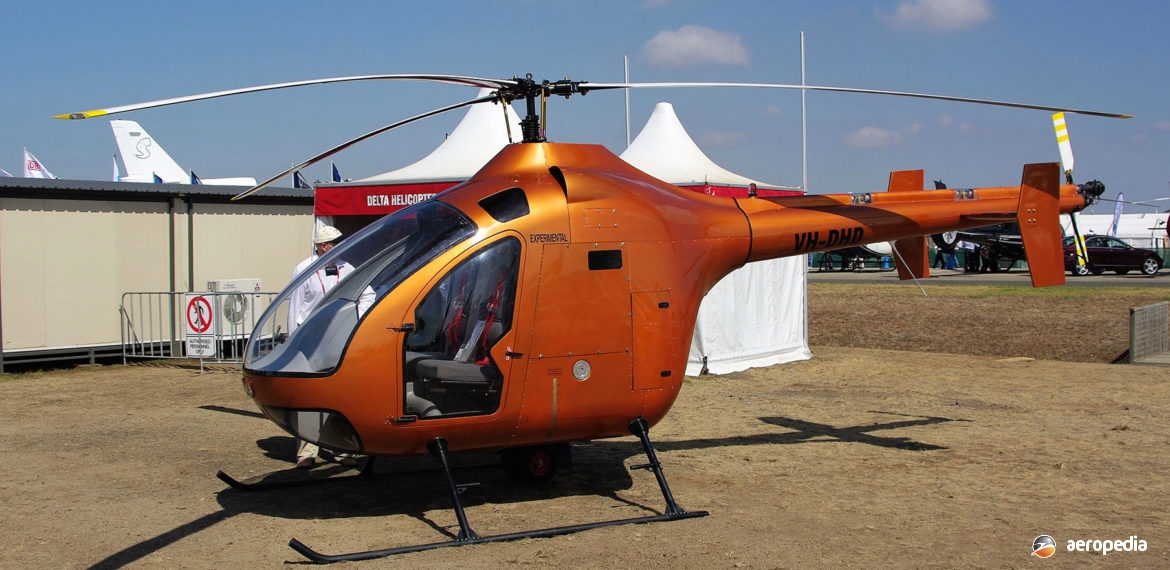Photograph:
Prototype Delta D-2 VH-DHD (c/n D2-0001) at the Australian International Air Show at Avalon, VIC in March 2009 (David C Eyre)
Country of origin:
Australia
Description:
Light sport and training helicopter
Power Plant:
One 135 kw (180 hp) Deltahawk DH-180 V-4 four-cylinder, two-stroke, air-cooled, turbocharged, diesel engine
Specifications:
- Length: 6.48 m (21 ft 3 in)
- Height: 2.69 m (8 ft 10 in)
- Rotor diameter: 6.5 m (21 ft 4 in)
- Max speed: 220 km/h (137 mph)
- Cruising speed: 191 km/h (119 mph)
- Endurance: 4 hours
- Max fuel load with one person on board: 96 kg (212 lb)
- Max height: 4,200 m (13,780 ft)
- Range: 700 km (435 miles)
- Empty weight: 601 kg (1,325 lb)
- Loaded weight: 846 kg (1,977 lb)
- Max disposable load weight: 296 kg (652 lb)
History:
One of a new range of helicopters being produced for the light training market, the D-2 was produced by Delta Development Company of Tonah in Queensland and was a diesel engine powered light helicopter with a skid landing gear. The prototype VH-DHD (c/n D2-0001) was first flown in mid 2009 and was registered on 23 February that year. The machine was the idea of Graeme Smith and Andrew Reid and was designed around the Deltahawk 135 kw (180 hp) dual turbo-supercharged, V-4 diesel engine, being the first helicopter in the world with a diesel engine.
This engine, produced by Deltahawk Diesel Engines of Wisconsin, USA, maintained its full rated power to 5,182 m (17,000 ft) and 70 per cent power at 9,144 m (30,000 ft). It had a fully installed weight of 110 kg (360 lb). The D-2 was aimed at the low-cost helicopter market to help resolve problems with the availability of Avgas in rural and remote areas of Australia.
The Delta D-2 machine was described as a “new era in aviation”, “the first diesel-powered helicopter in the world with an installed power of 149 kw (200 hp)” and “the first bio fuel capable helicopter”. The diesel engine was claimed to burn 40 per cent less fuel than standard gasoline aviation engines, and 75 per cent less than turbine engines. It was expected to give 30 to 40 per cent more range per gallon of fuel. It was intended to be supplied to customers in kit form. It was expected it would be available in a self-assembled kit form for use by farmers on remote farms who already operated diesel engines in their trucks, tractors and farm machinery.
The Delta D-2 machine had two-seats and the structure and systems were designed by Queensland aeronautical engineer, William ‘Bill’ Whitney, to comply with FAA and CAA requirements for normal airworthiness category certification. It had a three-blade fully-articulated rotor head with carbon composite blades. Initially it was expected to be made available in kit form in the Experimental Category. The prototype made its debut when placed on display at the Australian International Air Show at Avalon in March 2009.
The D-2 received some financial and commercial support in 2010 from the Australian Federal Government via the AusIndustry Agency which helped in relation to commercialising the Company and the production of the prototype aircraft, it being said it was commercially promising and innovative in technology. After that the Company, Delta Helicopters, sought a financial partner to invest in the design and further development, the design being advertised as an innovative design and the first diesel-powered helicopter in the world.
However, by 2020 no further Delta D-2 helicopters are known to have been completed and it still had not been placed in production, it being reported that production examples of the DH-200 diesel engine had not been made available and the engine company was still carrying out tests of the engine.

